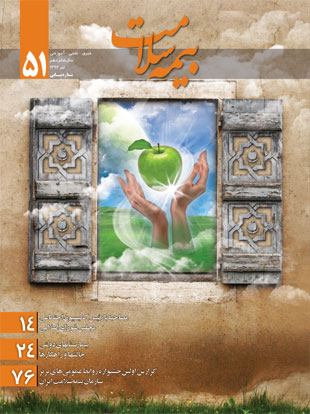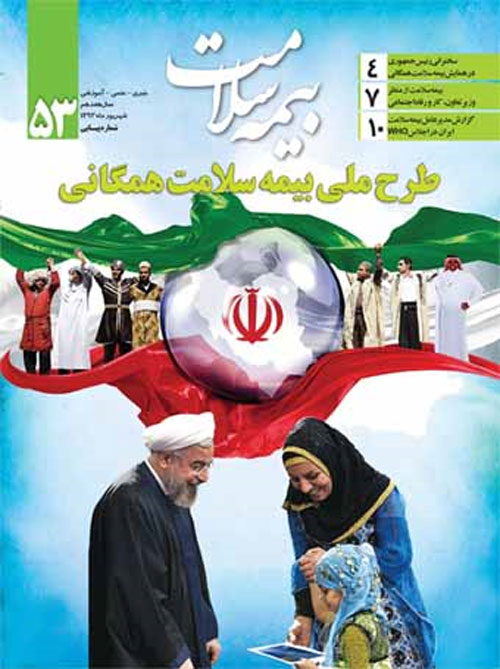فهرست مطالب

فصلنامه بیمه سلامت
سال شانزدهم شماره 51 (تیر 1392)
- تاریخ انتشار: 1392/04/12
- تعداد عناوین: 27
- سخن نخست
- دیدگاه
-
صفحه 3
- اخبار
-
صفحه 4
- گفت وگو
-
نظام بیمه درمان درکشور باید از حالت چندگانه خارج شود / مصاحبه اختصاصی بیمه سلامت با دکترعبدالرضا عزیزی رئیس کمیسیون اجتماعی مجلسصفحه 14
-
قراردادن کل جمعیت کشور در حمایت چتر بیمه سلامت ایران / دکتر محمدباقرهداوند مدیرعامل سازمان بیمه سلامت ایرانصفحه 18
- مقاله
-
صفحه 50
- گزارش
-
صفحه 82
- فراخوان
-
صفحه 86
- قوانین
-
صفحه 90
-
Page 20Japan was able to establish a universal health insurance system in 1961 because of several advantageous conditions that existed at this time. Furthermore, this was precisely the right time for japan to implement a universal health insurance system, due to the convergence of these conditions. There were at least three such conditions when japan established this system, in addition to a strong political will and an incremental approach toward universal coverage. First, the costs of health care were low. Second, japan was achieving high economic growth. Third, the people shared a sense of solidarity during this difficult post-war period. All these conditions facilitated the smooth implementation of universal health insurance in japan. At present, however, conditions have changed; health care expenditures are large and still growing, the population is aging, and economic growth is currently stagnant and uncertain going forward. Moreover, people are becoming diversified, income disparities are increasing, and their sense of solidarity may be deteriorating. This paper examines the conditions that enabled the establishment of universal health insurance coverage about five decades ago and discusses the conditions that sustain the system under the current changing conditions in japan. These analyses will not only facilitate informed decisions for future reforms in japan, they will also provide insights for those countries that are interested in such a system.
-
Page 24A hospital is the center of the focus of numerous medical, financial, managing, supportive, and lawful processes, and different strata are involved and influential in its accomplishments, both directly and indirectly, which are consisted of the patients and their families, the treatment team, health insurance organizations, medical sciences universities, policy holders, finance allocators, government, etc… regarding the essentiality of the hospital services and enumerable difficulties in this social institution, the necessity of making improvements in its situation all around the country is highlighted. The existing challenges in hospital atmospheres in diverse credit and financial sector, management, staff, evaluation, responsive, inner sections collaborations, and privatization sectors, etc… are researchable. Executing amendments in hospital affairs and having appropriate reactions towards its challenges are probable, although they are difficult. Via delivering practical solutions threats could be decreased and in some cases they could be conversed to opportunities.
-
Page 32Throughout all studied countries, the movement towards the public social insurance coverage is traced to be spontaneous with a systematic progression throughout the whole process of evolution. The organizational resolutions have delivered diverse ways of coming to such developments. Their classification that was initiated from the permanent progression of different disease funds was deliberately executed, and then was directed towards the progression process of membership by the lawful attempts of the central health insurance organization. It should also be mentioned that the speed of evolution differentiates among diverse countries.
-
Page 38Since the human birth and the initiation o his life on the earth, different diseases were also born, and health threatening abnormalities were created. To get released from the hardships and pains caused by the diseases, human being started a survey for the treatments and solutions of obtaining health, based upon the time requirements. Gradually, with the creation of the communities the diseases changed spontaneously and the necessity for novel resources to obtain health status became essential, and the human resources, financial resources, and also medical facilities and equipments shifted and developed from their primary to the present form. Appearance of the medical and health economics, along with the technological progressions in order to organize the mentioned resources to prevent and treat illnesses and obtaining health became essential, which has gained its status in universities as an interdisciplinary field of study. Environmental and demographic factors have direct roles in health economics and sometimes threaten the health economic resources, e.g. age, gender, living place, occupation, education, and income indexes, disease patterns, weather, geographic and environmental situation, etc… these elements directly cause changes in the health cycle and make changes in health economic resources. According to the limited resources of the health sector, this point is considered as one of the most important challenges of the health economic.
-
Page 44The health status of the people is related to the social and economic traits and structure. This important fact is the pillar of an effectual policy holding on the promotion o the health status of the people. Even though there has been considerable attempts in the field of finance and provision of appropriate health services and guarantee the efficiency o such services, but health is a broader issue than merely provision o health services. This belief is increasingly admitted and highlighted that health is not only determined by the behavioral, biologic, and genetic factors, but the social, economic, and environmental determining factors are also crucial. The social actors with the 50% influence on health status are the most effective one in health economics of the society. Of the most principal social element which would be mentioned in this article are the social stratification, inequity, solidarity, protection and unemployment.
-
Page 46Inside health insurance system, if the insured encounter a disease or an incident, they would refer to a medical center and benefit from the medical services, and this issue is of cost both to the individual and the insurer organizations. Encouraging the people to take care of themselves with the help of special mediums, would lead to less disease and incidents and consequently to a decrease in health expenditures, and a higher social health status. The increase of per capita for those who deliberately execute dangerous deeds from health perspective, or its decrease would encourage the non-hazardous activity insured to maintain their health status and lessen the national insurance expenditures would result in more and more justice in financial health resources distribution. This viewpoint would be practical under the legislative framework.
-
Page 50Thinking about the future for the present activities and steps is essential for the human being. Thoughtless reaction towards the future is probable, while acting is impossible, as it necessitates prediction. Henceforth, the future images (aims, destinations, hopes, concerns, and wishes) are the precedents of the present activities. Therefore, future could be formed and verified, designed, and formed through aim-oriented activities. To act wisely, one should be aware of the consequences of himself and others’ paces. Other reactions and uncontrollable should also be scrutinized. These results manifest themselves merely in the future. Henceforth, people not only attempt to comprehend the current coincidences, but they try to identify the probable occurrences or the potential happenings that might take place in specific situations in the future. Through these hypothetical verifications, the individuals verify their present situation, pursue their activities, and pass through the material and social time and space bedrock.
-
Page 54During years, organizations have gained experiences and knowledge through different activities, which are of great value and could aid them in order to execute their organizational processes in the future. This knowledge which is referred to as “organizational knowledge” is obtained from projects and different proposal fulfillment, encountering with new occupational conditions and difficulties, or innovations in direction of causing acceleration in the professional progressions. Therefore, organizational knowledge is of the main assets of an organization and is in need of management, and could have the most influence in avoiding the repetition of the past mistakes. The organizational memory system is responsible for accumulation of the organizational knowledge and its active redistribution among the workers and the agents of an organization. Under such a situation, the organizational memory – the administered organizational knowledge provides an appropriate bedrock for the organizational acquisition, and exchanges experiences and learned stuff among the individuals and different occupational groups, and consequently it results in the organizational potentiality. There are merely the questioning and analyzing minds or the knowledgeoriented staff who change the information into knowledge, through pre- hypotheses and theories of their minds. The appropriate organizational bedrock which rears such individuals inside itself, and also the way that the organization treats them, are of the debates of this article.
-
Page 62When an organization is created, it is in need of resources and facilities to gain its goals, and the most important factor is human resources. Individuals who enter the organization expect to obtain their own goals, in return for their attempts and their loyalty towards the organization. Organizational commitment, as an occupational viewpoint and perspective, is capable of delivering efficient information for planning, organizing, increase in efficiency, high activities, decrease in off works and delays less replacements, and a better usage of the resources and higher productivities to the managers. Failure in creating such commitments and dependency among the staff of the organization would result in the increase of the high expenditures for establishment of the control systems, and exact and complicated supervision. Organizational commitment (with the emphasis on Allen & Mayer Model) is dependant o three principal issues which are emotional, normative, and continuous commitments. Through the conceptional differences of the triple issues of organizational commitments, which each one of them are relatively dependant, it would be resulted that each one is the consequence of a specific pre-opportunity. This study is an attempt to measure the outcomes of the organizational commitments (with the emphasis on Allen & Mayer Model) and its relation with staying of the staff in the organization and also deliver resolutions for the promotion of the organizational commitments.
-
Page 70Organizational knowledge is counted as one of the main assets of the 21st century companies, and its efficient managing would lead towards the progression of the organizational quality. “Knowledge Management” is a term which has become dominant in the present business management literature. The professionals in this field have introduced numerous key factors in order to execute the knowledge management, successfully such as the organizational innovation and acquisition. This article delivers a brief definition of knowledge management, and organizational innovation and acquisition, and the relevant view and initiative points, affective factors, the kinds and consequently the success key factors.


